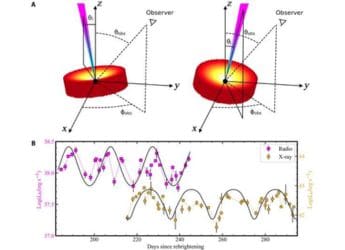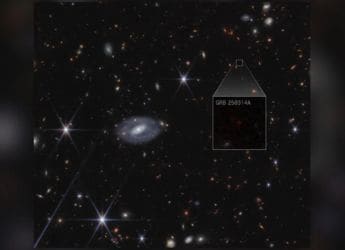- Home
- Science
- Science News
- NASA TEMPO Satellite to Continue Tracking Pollution Hourly from Space Until 2026
NASA TEMPO Satellite to Continue Tracking Pollution Hourly from Space Until 2026
NASA’s TEMPO (Tropospheric Emissions: Monitoring of Pollution) mission, launched in 2023, is revolutionising how we monitor air quality.

Photo Credit: NOAA/NESDIS/Center for Satellite Applications and Research
TEMPO, launched by NASA in 2023, tracks air pollution from 22,000 miles above Earth
The tropospheric mission of NASA was launched in 2023 to monitor pollution. It was abbreviated as TEMPO and has revolutionised the scientists' observation of the air quality from space. It was located around 22,000 miles above the Earth, and it uses a spectrometer to collect daytime air quality data on an hourly basis over North America. It covers small areas within a few square miles and significantly advances technologies, offering only one-time readings per day. This mission was successful within 20 months at its prime phase from June 19, 2025, and is now extended till September 2026 because of the exceptional quality of the data.
TEMPO Tracks the Air Quality
As per NASA, TEMPO keeps a track of the pollutants such as nitrogen oxides, formaldehyde, and ozone in the troposphere, which is the lowest atmospheric layer. This layer gets triggered by the power plants, vehicle emissions, dust, smog, and wildfire smoke. It gives hourly data rather than once a day, said Laura Judd, a researcher at NASA. Through this, we get to know about the emissions change over time. Further, how to monitor smog in the city or wildfire smoke. Such a real-life incident helps astronomers understand the evolution of air pollution in detail.
The major milestone during this mission was to get sub-three-hour data, which allows quicker air quality alerts. This enhances the decision-making and helps the first responders, said the lead data scientist at NASA's Atmospheric Science Data Centre, Hazem Mahmoud. With over 800 users, TEMPO has passed two petabytes of data downloads in a year. It proves the immense value of the health researchers and air quality forecasters.
NASA's Collaboration with NOAA and SAO
NASA worked together with NOAA and the Smithsonian Astrophysical Observatory, the former producing the aerosol products for distinguishing smoke from dust and analysing the concentration. As per Xiong Liu, the principal investigator, these datasets enhance the forecast of pollution, improve the models, and support public alerts at the time of peak emissions.
NASA's Earth Venture Instrument program is running the TEMPO mission and a global constellation of air monitors, along with GEMS of South Korea and Sentinel-4 of ESA. The formal mission review this and evaluate the progress, inform future space-based air quality efforts, and be helpful in refining the goals.
Get your daily dose of tech news, reviews, and insights, in under 80 characters on Gadgets 360 Turbo. Connect with fellow tech lovers on our Forum. Follow us on X, Facebook, WhatsApp, Threads and Google News for instant updates. Catch all the action on our YouTube channel.
- Samsung Galaxy Unpacked 2025
- ChatGPT
- Redmi Note 14 Pro+
- iPhone 16
- Apple Vision Pro
- Oneplus 12
- OnePlus Nord CE 3 Lite 5G
- iPhone 13
- Xiaomi 14 Pro
- Oppo Find N3
- Tecno Spark Go (2023)
- Realme V30
- Best Phones Under 25000
- Samsung Galaxy S24 Series
- Cryptocurrency
- iQoo 12
- Samsung Galaxy S24 Ultra
- Giottus
- Samsung Galaxy Z Flip 5
- Apple 'Scary Fast'
- Housefull 5
- GoPro Hero 12 Black Review
- Invincible Season 2
- JioGlass
- HD Ready TV
- Laptop Under 50000
- Smartwatch Under 10000
- Latest Mobile Phones
- Compare Phones
- Redmi Note 15 5G
- Redmi Note 15 Pro 5G
- Redmi Note 15 Pro+ 5G
- Lava Play Max
- Poco C85 5G
- Honor Magic 8 Lite
- Jolla Phone
- Realme P4x 5G
- Asus ProArt P16
- MacBook Pro 14-inch (M5, 2025)
- OnePlus Pad Go 2
- Poco Pad M1
- Just Corseca Skywatch Pro
- Honor Watch X5
- Acerpure Nitro Z Series 100-inch QLED TV
- Samsung 43 Inch LED Ultra HD (4K) Smart TV (UA43UE81AFULXL)
- Asus ROG Ally
- Nintendo Switch Lite
- Haier 1.6 Ton 5 Star Inverter Split AC (HSU19G-MZAID5BN-INV)
- Haier 1.6 Ton 5 Star Inverter Split AC (HSU19G-MZAIM5BN-INV)












